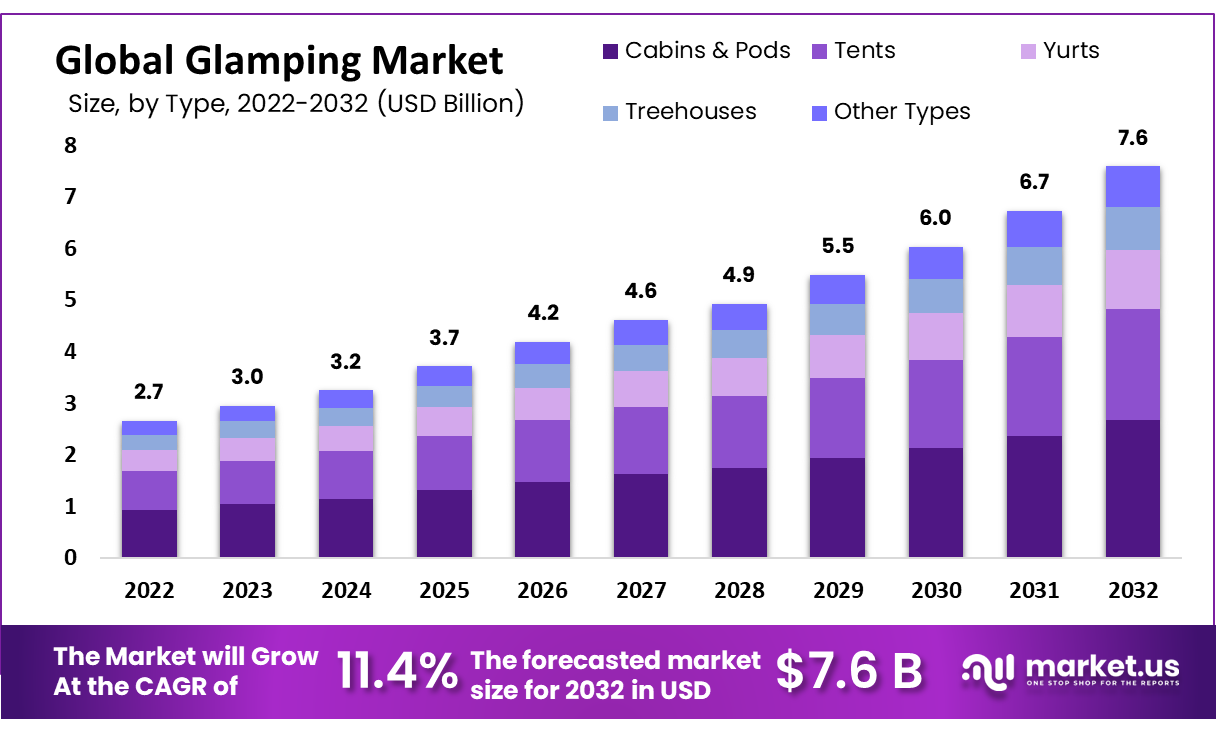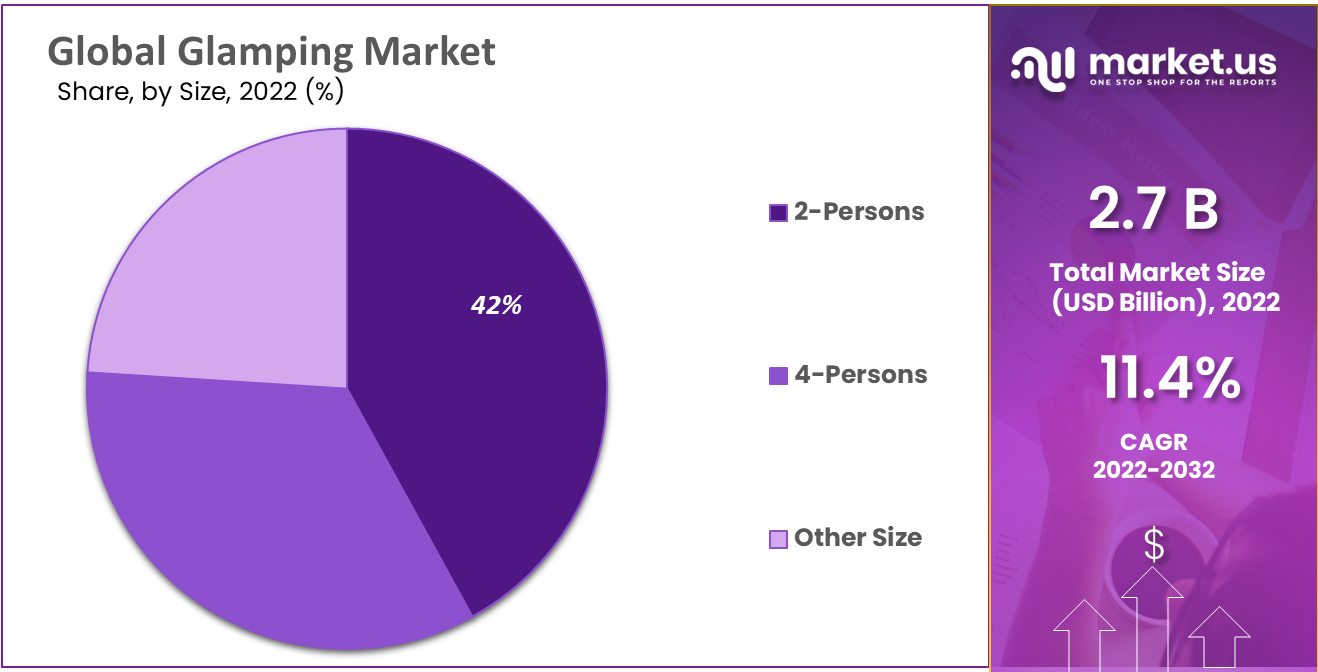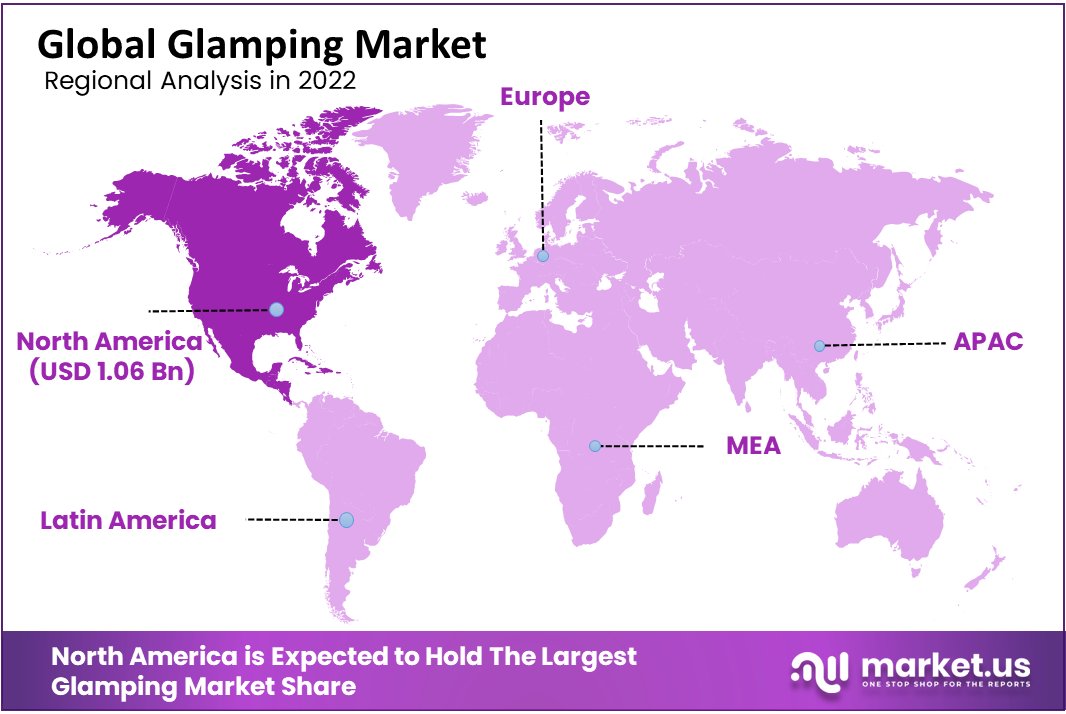Global Glamping Market By Type (Cabins & Pods, Tents, Yurts, Treehouses, and Others), By Size (2-Persons, 4-Persons, and Other Sizes), By Age Group (18-32 Years, 33-50 Years, 51-65 Years, and Above 65 Years), By Region and Companies - Industry Segment Outlook, Market Assessment, Competition Scenario, Trends, and Forecast 2023-2032
- Published date: Oct 2023
- Report ID: 102558
- Number of Pages: 355
- Format:
- keyboard_arrow_up
Quick Navigation
Report Overview
The Global Glamping Market size is expected to be worth around USD 7.6 Billion by 2032 from USD 2.7 Billion in 2022, growing at a CAGR of 11.40% during the forecast period from 2023 to 2032.
Glamping is where beautiful nature meets modern luxury. Glamping means comfortable camping with various amenities and facilities like beds, bars, Wi-Fi, bathrooms, spas, electricity, housekeeping services, and indoor plumbing access. These accommodations create sustainable tourism and eco-friendly space. It’s an amazing way to connect with nature and cherish the holidays with luxury facilities.
It’s getting more popular as individuals are taking breaks from the hustle and bustle of life and searching for various glamping ideas. Travelers enjoy an outing at different locations. As a result, glamping offers opulent services and facilities such as luxury tents, customized cottages, resorts, and many more facilities. These all factors contribute to the significant growth of the glamping market size.

Driving Factors
Outdoor Tourism Favors the Glamping Market
Travelers are enjoying an outing at different locations hence outdoor tourism is rapidly expanding and boosting the market growth. Increasing the income of individuals and taking a break from the hustle and bustle of life, outdoor tourism favors market growth.
As the market is expanding, several businesses offer creative glamping accommodations such as tents, villas, cabins, treehouses, lodges, tipis, and pods. One of the key factors that will drive the expansion of the glamping market during the forecast years is the availability of opulent services and amenities, as well as the large number of travelers who wish to connect with nature.
Social Media Influence Boosts the Market Growth
The rising social media influence among individuals contributes rapid growth of the glamping market. Moreover, several tourism companies offer holiday packages with major discounts accelerating the market growth.
Social media platforms such as Pinterest, Facebook, Instagram, etc. have played an important role in promoting market growth. Several glamping sites on social media attract individuals to visit glamping areas, resulting in the expansion of the market size and gaining more profit for entrepreneurs.
Restraining Factors
Seasonal Demand and Growing Competition Restrain the Market Growth
Owing to climate change, glamping sites probably have a short working season, which affects the company’s revenue and profit. It also provides difficulties in staffing and resource management.
Competition in the glamping market is rapidly increasing because companies expanding their offerings and new companies entering the market. this will lead to a reduction in profit and price wars. Moreover, glamping sites are dependent on natural resources, impacting local ecosystems.
Growth Opportunities
Diversification Of Offerings and Integration of Technology Drives the Market
The glamping market offers several opportunities to investors and entrepreneurs such as diversification of offerings, integration of technology, eco-tourism, etc. Glamping sites offer innovative and creative accommodations such as pods, yurts, treehouses, tents, and cabins. This attracts a wide range of individuals and increases revenue & profit. Modern technology such as keyless entry is used to amplify the glamping experience.
Glamping sites can work with other companies such as local food and beverage vendors or outdoor activity providers to offer a larger choice of experiences and provide more holiday packages to customers. The glamping market size can expand into new markets, such as family reunions or corporate retreats, by providing luxurious group lodging and other activities.
Trending Factors
Glamper-vanning is Trending in the Glamping Market
More individuals are turning vans and other vehicles into opulent mobile accommodations so they may travel and explore several destinations by enjoying glamping luxuries. While glamping has typically been associated with remote, natural areas, some glamping sites are now found in urban settings, offering distinctive accommodations in cities.
Services such as personalized menus and activities catered to specific guests’ interests are now being offered by glamping sites. The glamping experience is being improved by the use of technology, such as giving visitors tablets or smartphones to access virtual reality experiences exhibiting nearby sites or operating smart elements in their accommodations.
Type Analysis
Based on type, the market for glamping market is segmented into cabins & pods, tents, yurts, treehouses, and others. Among these types, the cabin & pods segment is the most lucrative in the global glamping market.
Customers usually prefer cabins & pods as they are well equipped with all the amenities like beds, Wi-Fi, bathrooms, spas, electricity, housekeeping services, etc. Cabineering and glamper-vanning are new trends in glamping that provide several accommodations and give the comfort of home.
Moreover, cabins & pods provide more safety and involve latches & locks, which is the main requirement of customers nowadays. The global glamping market size is anticipated to see new growth opportunities due to factors including expanding consumer disposable income, a growing development of enhanced and advanced tourism infrastructure, and rising health consciousness among the general populace.
Size Analysis
By size, the segment is further divided into 2-persons, 4-persons, and others. The 4-person segment is estimated to be the most lucrative segment in the global glamping market size in 2022. The 4-person segment contributes a major share because group travelers are in high demand. During the forecast period, it is anticipated that changes in consumer spending and lifestyle will present enormous opportunities for the glamping industry.
Many college and office groups prefer to visit glamping areas at the weekend to feel relaxed and enjoy nature. Family can prefer this segment to enjoy with their kids or friends.
Age-Group Analysis
Based on age group, the segment is divided into 18-32 years, 33-50 years, 51-65 years, and above 65 years. Among these end-users, the 18-32 years segment is predicted to be the most dominating segment in the global glamping market, with the largest revenue share of 40% during the forecast period. Glamping preference is being influenced by the increased popularity of solo travel among youngsters.
Additionally, 20% of glamping travelers are couples without kids. Thus, the market for glamping is being driven by an increasing number of younger travelers with more disposable income. Youngsters growing preference for music festivals, concerts, and destination weddings is predicted to present the market with excellent growth prospects during the forecast period.

Key Market Segments
Based on Type
- Cabins & Pods
- Tents
- Yurts
- Treehouses
- Other Types
Based on Size
- 2-Persons
- 4-Persons
- Other Size
Based on Age-Group
- 18-32 Years
- 33-50 Years
- 51-65 Years
- Above 65 Years
COVID-19 Impact Analysis
The COVID-19 pandemic had a mixed impact on the glamping market. Increase demand for outdoor activities has increased after the pandemic. Glamping has become more popular as many customers were preferring safe and socially distanced options, to stay away from crowded resorts and hotels. An effect of the pandemic on the glamping industry has been a rise in demand for exclusive, isolated, and secluded accommodations that provide protection and safety.
More people are choosing glamping sites that provide contactless check-in and check-out options and are located in less populated areas. A rise in demand has also been observed for glamping accommodations with private amenities including restrooms, outdoor hot tubs, and fire pits.
On the other hand, due to health and safety worries, demand has decreased at glamping sites that rely on public areas and amenities, such as community kitchens, showers, and eating areas. Many glamping businesses have adjusted to the shifting demand by adding new safety precautions, like stricter cleaning and sanitation procedures, and by providing more exclusive and self-contained lodging options
Regional Analysis
North America is estimated to be the most lucrative market in the global glamping market, with the largest market share of 40% during the forecast period. The region dominates the glamping market because of the increase in the popularity of glamping among consumers, as well as the number of tour companies and online glamping services in the area. The growing desire for a comfortable lifestyle and increasing demand for outdoor activities, and opulent vacations are driving the expansion of the glamping industry in North America.
Additionally, glamping has become a well-liked activity among customers because of open-air live music events and social media influencers. Owing to rising levels of disposable income and the region’s expanding tourism industry, Asia-Pacific is predicted to have significant growth throughout the projected period of 2023 to 2032.

Key Regions and Countries Covered in this Report
- North America
- The US
- Canada
- Mexico
- Western Europe
- Germany
- France
- The UK
- Spain
- Italy
- Portugal
- Ireland
- Austria
- Switzerland
- Benelux
- Nordic
- Rest of Western Europe
- Eastern Europe
- Russia
- Poland
- The Czech Republic
- Greece
- Rest of Eastern Europe
- APAC
- China
- Japan
- South Korea
- India
- Australia & New Zealand
- Indonesia
- Malaysia
- Philippines
- Singapore
- Thailand
- Vietnam
- Rest of APAC
- Latin America
- Brazil
- Colombia
- Chile
- Argentina
- Costa Rica
- Rest of Latin America
- Middle East & Africa
- Algeria
- Egypt
- Israel
- Kuwait
- Nigeria
- Saudi Arabia
- South Africa
- Turkey
- United Arab Emirates
- Rest of MEA
Several key players are focused on a variety of strategic policies to develop their respective businesses in foreign markets. Several glamping market companies are concentrating on expanding their existing business and providing different facilities.
Furthermore, businesses in the glamping market size are developing new technology and portfolio expansion strategies through investments mergers, and acquisitions. In addition, several key players are diversifying their services offering to grow the market share.
Market Key Players
Listed below are some of the most prominent Glamping Market industry players.
- Eco Retreats
- Johnson Outdoors Inc
- Tanja Lagoon Camp
- Wildman Wilderness Lodge
- Baillie Lodges
- Oase Outdoors
- Collective Retreats
- Under Canvas
- Paperbark Camp
- Tentrr
- The Coleman Company
- Newell Brands Inc
- Other Key Players
Recent Developments
- In March 2022, the EcoFlow River series was launched by EcoFlow (portable power station and renewable energy solution company). A portable power series accessible for both outdoor and home purposes.
Report Scope:
Report Features Description Market Value (2022) USD 2.65 Bn Forecast Revenue (2032) USD 7.6 Bn CAGR (2023-2032) 11.4 % Base Year for Estimation 2022 Historic Period 2016-2022 Forecast Period 2023-2032 Report Coverage Revenue Forecast, Market Dynamics, COVID-19 Impact, Competitive Landscape, Recent Developments Segments Covered Type (Cabins & Pods, Tents, Yurts, Treehouses, and Others), Size (2-Persons, 4-Persons, and Others), By Age Group (18-32 Years, 33-50 Years, 51-65 Years, and Above 65 Years) Regional Analysis North America – The US, Canada, & Mexico; Western Europe – Germany, France, The UK, Spain, Italy, Portugal, Ireland, Austria, Switzerland, Benelux, Nordic, & Rest of Western Europe; Eastern Europe – Russia, Poland, The Czech Republic, Greece, & Rest of Eastern Europe; APAC – China, Japan, South Korea, India, Australia & New Zealand, Indonesia, Malaysia, Philippines, Singapore, Thailand, Vietnam, & Rest of APAC; Latin America – Brazil, Colombia, Chile, Argentina, Costa Rica, & Rest of Latin America; the Middle East & Africa – Algeria, Egypt, Israel, Kuwait, Nigeria, Saudi Arabia, South Africa, Turkey, United Arab Emirates, & Rest of MEA Competitive Landscape Eco Retreats, Johnson Outdoors Inc, Tanja Lagoon Camp, Wildman Wilderness Lodge, Baillie Lodges, Oase Outdoors, Collective Retreats, Under Canvas, Paperbark Camp, Tentrr, The Coleman Company, Newell Brands Inc, Other Key Players Customization Scope Customization for segments, region/country-level will be provided. Moreover, additional customization can be done based on the requirements. Purchase Options We have three licenses to opt for Single User License, Multi-User License (Up to 5 Users), Corporate Use License (Unlimited User and Printable PDF) Frequently Asked Questions (FAQ)
What is glamping?Glamping is a blend of "glamorous" and "camping," offering a luxurious camping experience that combines the comforts of a hotel with the immersive nature experience of traditional camping.
What are the key features of glamping?Glamping accommodations typically include spacious tents or cabins with comfortable beds, furniture, electricity, heating/cooling, private bathrooms, and sometimes additional amenities like hot tubs, Wi-Fi, and gourmet meals.
Where can you find glamping sites?Glamping sites can be found in a variety of locations, including national parks, private estates, scenic wilderness areas, and coastal regions. They are often set up in picturesque natural settings.
What types of accommodations are offered in the glamping market?The glamping market offers a wide range of accommodations, such as safari tents, yurts, treehouses, luxury RVs, geodesic domes, and eco-cabins. Each accommodation type provides a unique and upscale camping experience.
What are the benefits of glamping?Glamping allows people to enjoy the beauty of nature while enjoying the comforts and amenities of a luxury accommodation. It offers a unique and memorable experience, with a focus on relaxation, adventure, and immersion in nature.

- Eco Retreats
- Johnson Outdoors Inc
- Tanja Lagoon Camp
- Wildman Wilderness Lodge
- Baillie Lodges
- Oase Outdoors
- Collective Retreats
- Under Canvas
- Paperbark Camp
- Tentrr
- The Coleman Company
- Newell Brands Inc
- Other Key Players
- settingsSettings
Our Clients
| Single User $4,599 $3,499 USD / per unit save 24% | Multi User $5,999 $4,299 USD / per unit save 28% | Corporate User $7,299 $4,999 USD / per unit save 32% | |
|---|---|---|---|
| e-Access | |||
| Report Library Access | |||
| Data Set (Excel) | |||
| Company Profile Library Access | |||
| Interactive Dashboard | |||
| Free Custumization | No | up to 10 hrs work | up to 30 hrs work |
| Accessibility | 1 User | 2-5 User | Unlimited |
| Analyst Support | up to 20 hrs | up to 40 hrs | up to 50 hrs |
| Benefit | Up to 20% off on next purchase | Up to 25% off on next purchase | Up to 30% off on next purchase |
| Buy Now ($ 3,499) | Buy Now ($ 4,299) | Buy Now ($ 4,999) |












